11 August 2025
Rise of the AI Naturalist
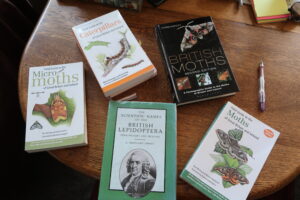
Flipping through a bulky moth field guide book can be extremely intimidating. Opening up a trap full of hundreds of similar-looking insects even more so.
While I may have embellished my feelings about my first moth trap in an earlier blog, I’ll come clean now and say that frustration was the overwhelming sensation once I sat down to start identifying. While some moths are truly wonders of color, the vast majority are different configurations of brown, black, and white, unfortunately making things hard for an untrained eye.
With artificial intelligence seemingly ubiquitous these days, I knew there could be online tools out there to help speed up my tasks. I began with reverse Google image searching, a decade-old technology that allows you to search the web using an image rather than a search query. I would simply download the photos off my camera into the search engine and receive photos of moths from scientific websites that looked similar if not exactly the same, cutting down time trying to pinpoint a species name.
Along with the help of the “Flying Tonight” tab on Yorkshire Moths, I quickly got the hang of moth identification without having to flip back and forth between field guide pages for hours until I could make at most an educated guess. As it turns out, there’s an even faster method.
Futuristic Technology in the Ancient Woods
I recently had the opportunity to accompany a group of seasoned moth-ers for an expedition into the ancient woods near Castle Howard. Bright and early on a Friday morning, Patrick and I drove the scenic 15 miles to where the group had sprinkled the nearby forest with battery-powered light traps overnight.
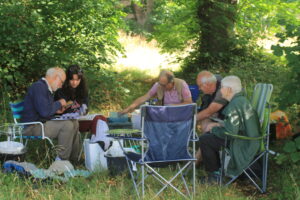
As we followed along during the trap retrieval, it quickly became obvious I was in the company of people who knew these woods and their inhabitants intimately. They waded through waist-high brambles in shorts, brushing aside spiders larger than I cared to meet, confident in the knowledge that none of them posed any real threat. Years of experience, and a familiarity with the local ecology, had replaced fear with ease. I, on the other hand, still eyed anything with more than six legs with caution.
Once we’d arranged ourselves into a colorful ring of folding camping-chairs, things began moving fast. Each moth-er examined the contents of their own traps, jotting species names and numbers by hand into notebooks. Both a respectable speed and precision were present, but also a passion that was inspiring. Every so often, a specimen with unusually bold markings or rich coloring would be passed my way, and that morning, I finally met my first Ruby Tiger.
Talk turned to moth-ing techniques old and new. Some of the moth-ers’ traps were locally sourced, the frame holding the bulb refashioned from an old lampshade. The Robinson trap, I was told, is the Rolls Royce of moth traps. Some enthusiasts will stay out all night beside their traps, watching each arrival as it flutters in. Most know their field guides almost by heart. But now, when they get stuck, they’ll simply snap a photo on an app called ObsIdentify and receive a species suggestion in seconds.
Their field guides still sat dutifully in their laps like well-worn bibles, spines cracked and covers long gone. But beside them, smartphones waited quietly, ready to offer an answer when memory faltered — the old and the new in peaceful coexistence.
At one point, two moth-ers debated a particularly tricky specimen. One of them snapped a picture and posed the question to ObsIdentify, but even this result spurred further discourse. I’ve since forgotten the exact details of the moth, but I remember the final line spoken before they all decided to jot down the given species name and move on: “Who are we to question the great and mighty AI?” Coming from someone with decades of experience and a lifetime of field notes to back it up, it felt like a sign of the times.
A few days later, despite an unpromising weather forecast, Patrick and I set another trap back here in the gardens of Shandy Hall. The temperature dropped overnight, and the cold wind seemed to have swept most of the more colorful and exciting moths out of the beams of our bulb.
With less striking visuals to aid in our identification we made the executive decision to enlist the help of the aforementioned ObsIdentify for our early morning screening of the trap. Here’s how it went:
Swallow Prominent (Pheosia tremula)
The Swallow Prominent was our unmistakable celebrity that morning: a moth so distinctive the use of AI felt redundant. Its sharp wedge-shaped dash along the forewing is the sort of clean-cut feature you dream of as a beginner, a bold arrow in a sea of smudges. I’ve taken quite a liking to the Prominents, so I was excited to add another species to my list. Docile to the point of indifference, it sat perfectly still for photos, clearly unfazed by our early-morning enthusiasm.
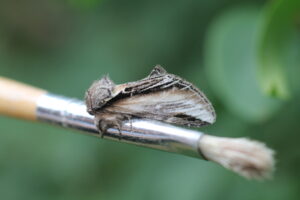
Its name is a small lesson in natural history Latin: Pheosia comes from a prickly plant, alluding to that wedge-shaped dash, while tremula means “shaking” or “trembling” — possibly a nod to both the moth’s quivering larval stage and its association with aspen (Populus tremula). The larvae also feed on willows, sallows, and other poplars, so it has no shortage of trees to choose from.
Single-dotted Wave (Idaea dimidiata)
This was a case of the AI humbling us. We dismissed its confident suggestion outright (“No, surely not!”), only to have the guidebook confirm the machine was, in fact, right. The Single-dotted Wave is a night visitor to flowers like Creeping Thistle, but its diet in captivity is far less picky, happily munching on withered dandelion leaves.
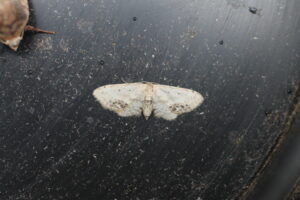
The name Idaea recalls Mount Ida, where the gods supposedly watched the Trojan War. An oddly grandiose image for a dainty moth. Dimidiata means “halved,” from the way its subterminal markings are boldly developed only on the dorsal half of the forewing. Once you notice it, you can’t unsee it, probably why AI gave us the confident label of “100% certainty.”
White-spotted Pug (Eupithecia tripunctaria)
Pugs are the bane of moth identifiers everywhere. Subtle differences in size, posture, and wing markings can separate dozens of nearly identical species. This is where AI really shines, at least in narrowing down the suspects before you dive into the finer details.
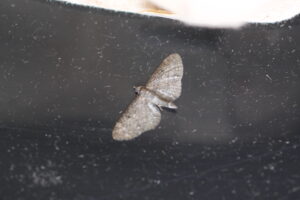
The White-spotted Pug overwinters as a pupa, hidden away in leaf litter or loose soil, and emerges with a name that is surprisingly literal: Eupithecia combines “good” and “dwarf,” a flattering nod to its small size and neat appearance, while tripunctaria refers to three pale spots breaking the subterminal white line on its forewing. Without AI’s suggestion, I might still be flipping pages.
Mystery Micro-moth (Argyresthia bonnetella)
AI stumbles here. Macro-moths are its comfort zone, but micro-moths are another story. Their minuscule size and the graininess of an iPhone photo mean even the algorithm will hedge its bets. This one, barely 5 mm long, was a silvery blur in the trap until I sent the photo to Dr. Fletcher, who confirmed it as Argyresthia bonnetella.
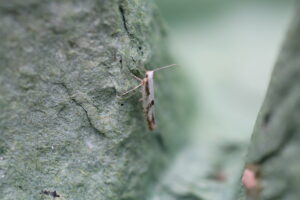
Its larvae feed on hawthorn, tunneling through terminal shoots before emerging. The name Argyresthia means “silver dress,” for the metallic sheen on the wings, while bonnetella honors Charles Bonnet, a Swiss entomologist who studied plant lice (though the link to moths remains mysterious). Perhaps the honor was bestowed to appreciate his contributions to the field of entomology in general. Even experts, human or machine, can’t explain every naming choice.
The Easy Way Out?
Artificial intelligence doesn’t have the most stellar reputation nowadays. While some may scoff and consider this AI method as taking the “easy way out,” I’d argue that it allows for the easiest passage in to the world of moth-ing.
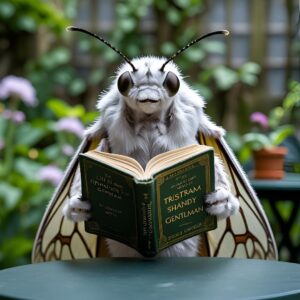
While the main purpose of identification apps like ObsIdentify is to provide accurate species names so that the records can support conservation work, they also serve a broader function: drawing people into a closer relationship with the natural world. With AI’s assistance, I dove into this expansive realm more quickly and confidently. With a short Gen-Z attention span and the initial lack of innate interest in these tiny creatures, would I have caught the “moth-ing bug” as easily without this technology?
If a single meeting between a moth and a smartphone can spark a new interest, then the technology has displayed its value. Despite their current imperfections, these tools can invite fresh eyes into the field — eyes that may go on to learn more and contribute further. The tools may now look different, but the impulse to seek out, record, and delight in the creatures that share our landscapes remains the exact same.
*Moths mentioned caught in trap on July 29, 2025
Post by Sophia Hernandez (UPenn intern)
Recent Moths
- Rise of the AI Naturalist
- Best Moths for a Haunted Abbey
- The Real and Fake Deaths of Moths
- The Colonizers of Yorkshire
- Glamour in the Dark: Two Newcomers Arrive at Shandy Hall
- 25 July 2023 – Collective Noun for Hawkmoths
- MOTH LIST to August 2023 with links
- 28 July 2023 – TRIPLE New Species Alert!
- 18 July 2023 – A Golden…Plusia!
- 13 July 2023 – Arts and Sciences
- 10 July 2023 – Rise of the Yellow Underwings
- 4 July 2023 – Cold-weather Catch






